SEE AFRICA BY AIR: Why a Helicopter Safari Offers a Whole New Perspective
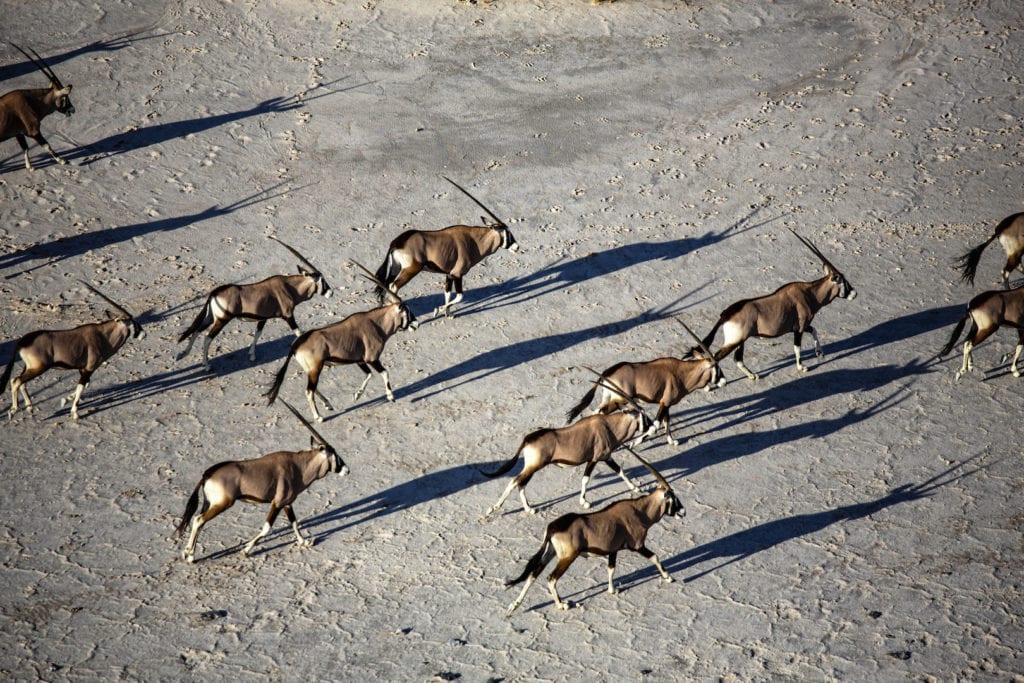
The vast expanse of the Great Rift Valley unfurls beneath you, the lofty plateau dropping away to be replaced by towering pinnacles of granite, cascading sand dunes and waters of deep blue fringed with the vibrant pink of flamingo feathers.
Your senses are honed, sound diminished by the insulated, muffling headphones, touch reduced in your secure and comfortable seat. Your thoughts explode, your vision acute, your mind absorbing every nuance of the landscape in a frenzy of colour, contrast and wonder. No particle of humanity exists here, no industrial scar mars the panorama; you are the first person to ever witness this remote wilderness.
…or so it seems.
Africa inundates us with a continual ebb and flow of life, the flora and fauna changing with the seasons, greenery almost as migratory as the wandering wildebeest and monochromatic herds of zebra. Yet so much of it remains unseen, untouched and unattainable.
A helicopter safari reveals another side of Africa, equally as raw and hostile as it is fragile and ephemeral. There are, of course, numerous sights that beg to be viewed from a more vertically-opportunistic perspective; the thunderous cascades of the mighty Zambezi as it plummets over Victoria Falls, the ruler-straight mesa of Table Mountain as it beckons precariously towards the convergence of two mighty oceans.
There is more to Africa than what appears on postcards, and the interior is often as utterly captivating as it is entirely untouched.
Part 1: A Day Over Kenya
Kenya is a wonderfully accessible country. There is so much to see within a convenient region, and even the most popular locations deserve recognition and attention. Yet there is so much to Kenya that is not only unfrequented but also remarkably unique and disparate from those more conventional excursions of the Mara and national parks.
The Great Rift Valley
North West of Kenya’s capital of Nairobi lies the Great Rift Valley. Spanning over ten countries and almost one and a half times longer than the US from coast to coast, Kenya’s claim on the Great Rift accounts for only a portion of its magnitude. Peppered with active volcanoes and saline lakes, rich forests and arid deserts, and reaching from below sea level to 1.7 miles above it, it is inordinately monumental. Suddenly, the Grand Canyon doesn’t seem quite so grand!
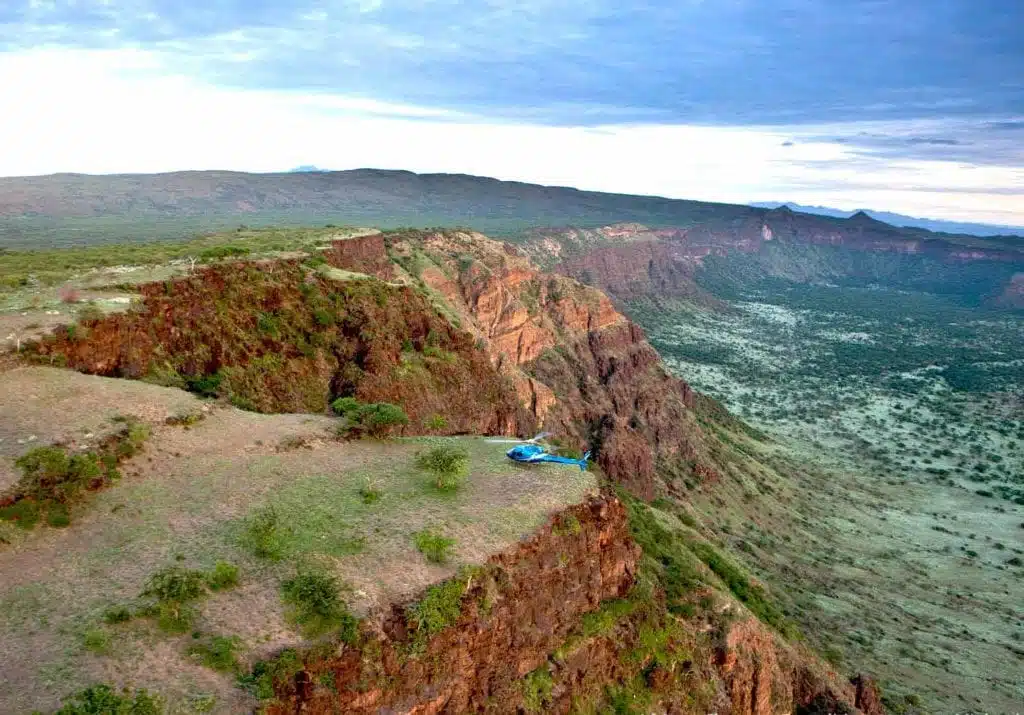
Encapsulating only a snapshot of this dissimilitude, a half-day helicopter excursion will transport you across the Kenyan landscape. The verdant Laikipia landscape teems with life as you pass weightlessly above it, gazing down upon the rolling hills, striated by the passage of time. Touching down on the perimeter of the Silale Crater reveals the sheer magnitude of the Rift’s scale. This single caldera is one of so many, swallowed by the valley despite its prodigious proportions.
Towering Dunes & Colorful Locals
Transported from the lush south-western valley, the continually-shifting dunes of Suguta offer a remarkably different photo opportunity. Driven by the wind, these constantly-moving mountains of sand appear on the horizon as a vast, ochre-hued sculpture, its sharp ridges contrasting with the azure sky.
Boarding the chopper again, the next destination is Lake Logipi, a hostile, salinic environment offering little hospitality for life. However, the highly alkaline waters are responsible for one remarkable spectacle. Microscopic cyanobacteria are abundant in Logipi’s briny water, and it is these tiny creatures that attract a flamboyance of visitors: flamingo. Migrating across thousands of miles, the filter-feeding flamingo syphon the cyanobacteria through their beaks for sustenance with a spectacular side-effect.
Without this soup-like diet borne of such an inhospitable location as Lake Logipi, flamingo would not only go hungry, they would also lose their iconic pink colour.
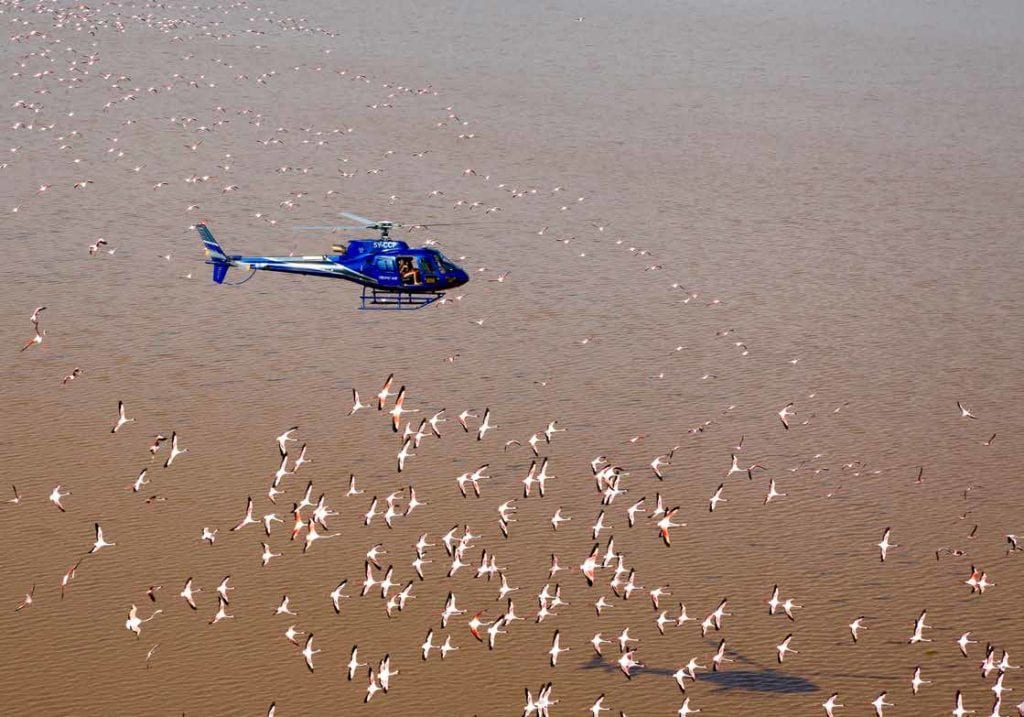
Further north, Lake Turkana is the world’s largest desert lake. Rimmed with numerous volcanoes, the unforgiving environment is all but unattainable by land, but by air it presents a remarkable tapestry of deep blue waters encapsulated by black volcanic rock and the slopping terracotta sides of the collapsed Nabuyatom volcano and surrounding hills.
A Sanctuary in the Desert
An oasis in an arid landscape, Mathew’s Range rises like a Garden of Eden, shrouded in a lush, ancient cycad forest clinging to its ragged crest. Homeward bound, your pilot swoops low over Samburu National Reserve, rich and abundant, and returning to the more amiable climate of Kenya’s centre. Over 7,000 elephant call Samburu home and can often be seen gracefully meandering through the valleys of Samburu.
This beguiling tour of Kenya’s many faces – from bitter lakes to abundant forests – is irreplicable by land; only under the whirling propellers of a helicopter is this achievable.
Part 2: Remaining Dry in the Okavango Delta
The flood plains of the Okavango are simply remarkable.
Drawing wildlife not only from all over Botswana but from across the African continent and even as far afield as Europe, the vast delta presents only a glimpse of its abundance by land. Okavango, Duba Plains and Mombo camps provide elegance under canvas on the perimeter of the interwoven waterways, while the spectacular Xugana Island Lodge presents 360 degrees of aquatic scenery.
Devine as they are, none of these venues can encapsulate the myriad spectacles of the greater Okavango. For that, you need to take to the air.
Life in the Delta
The flood plains are home to a cacophony of wildfowl, many migrating for thousands of miles to plunder the rich waterways, breed and raise their young. Buffalo careen through the shallow waters, sending plumes of whitewater into the air, while herds of zebra and lechwe keep a watchful eye out for prowling lions.
Much of this remains unseen by travelers, the wildlife often congregating in the least accessible regions of the delta.
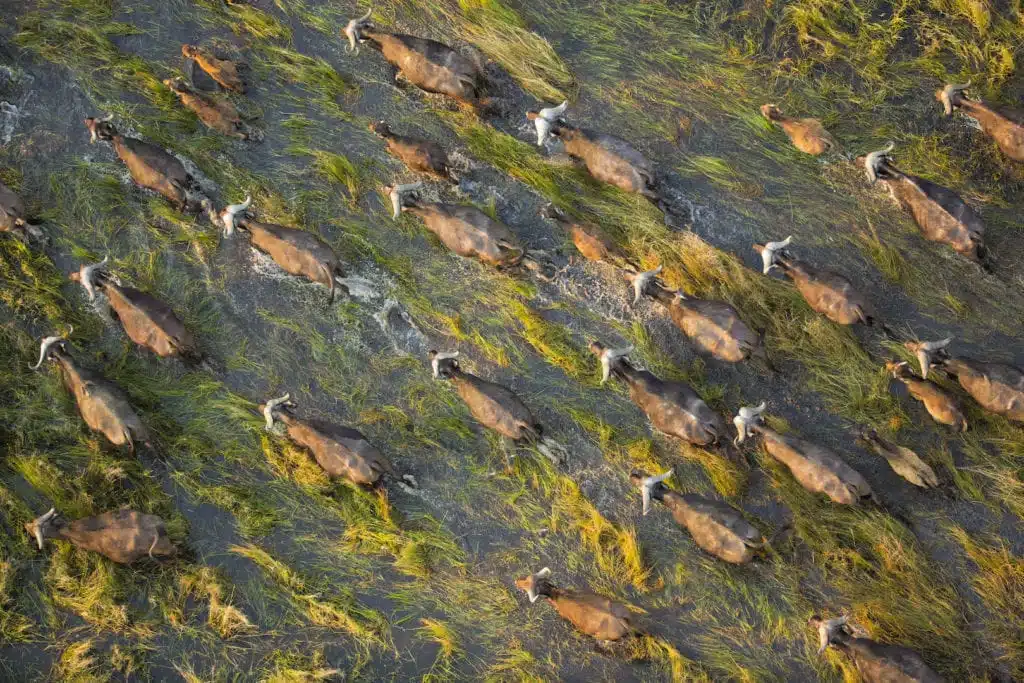
By helicopter, the Okavango opens up to you like a map unfurling at your feet. This incredible cradle of life is serene and tranquil at ground level; from the air, the vitality and importance of this immense web of rivers and estuaries become apparent.
Fly Back in Time
Botswana’s beauty and appeal don’t lie in the Okavango alone. Incorporating the country’s highest pinnacle, the UNESCO World Heritage Site of Tsodilo to the north-west borders of Botswana is sometimes dubbed the Louvre of the Desert. Sited in the northernmost reaches of the Kalahari Desert, the collection of foothills hosts some of the world’s most impeccable cave art, some 4,000 individual pieces estimated variously to date back between 1,000 and 20,000 years. This region of intense acheological interest has also revealed artefacts of over 70,000 years old and some of the world’s oldest evidence of human ritual.
By road, this remarkable spectacle is only for the truly dedicated. Remote, far from any major towns and at the end of a long four-hour off-road journey, it is an experience many would forego. On a helicopter safari, the site lies within a comfortable half-day round trip, with the added opportunity to witness the ever-changing landscapes beneath your propellors, from the water system of the delta, across the expansive Kalahari plains to this prodigious exhibition of ancient artwork.
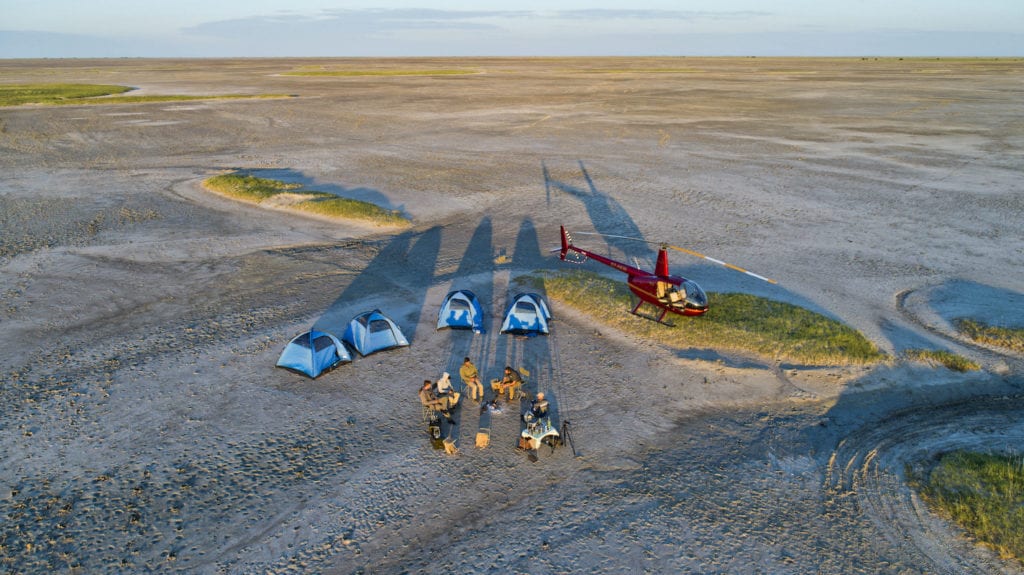
With such a variable landscape, confining yourself to a single aspect of Botswana is to barely glimpse its diversity. Roughly the size of Texas, weeks of travel would be required for an immersive Botswana adventure, but by helicopter, you can take in a melange of the country’s facets, alighting at established luxury camps and lodges, taking an airborne, half-day helicopter safari or whirling far into the savannah for a tented night under canvas.
Several traditional villages also welcome visitors, allowing you to gain a perspective of quintessential Africana, from food to daily life and exquisite craftwork.
The Majesty of Victoria Falls
On the border of Zambia and Zimbabwe, the mighty Zambezi River dramatically plummets some 100 meters in an eruption of sound and mist. In the local Lozi and Tonga dialects, it is aptly dubbed respectively ‘the Smoke that Thunders’ and ‘Boiling Water’. The roar of the falls, coupled with the cascading torrents flooding over their crest is something to behold, but the vast, one-mile span of this remarkable sight simply cannot be appreciated at ground level. Only a short flight from Botswana and the Okavango, Victoria Falls by helicopter is the only way to take in the sheer magnitude of this wonder of the natural world. 38,000 cubic feet of water gush over its brink every second, and viewing this immensity from the banks of the Zambezi simply doesn’t serve justice to the phenomenon.
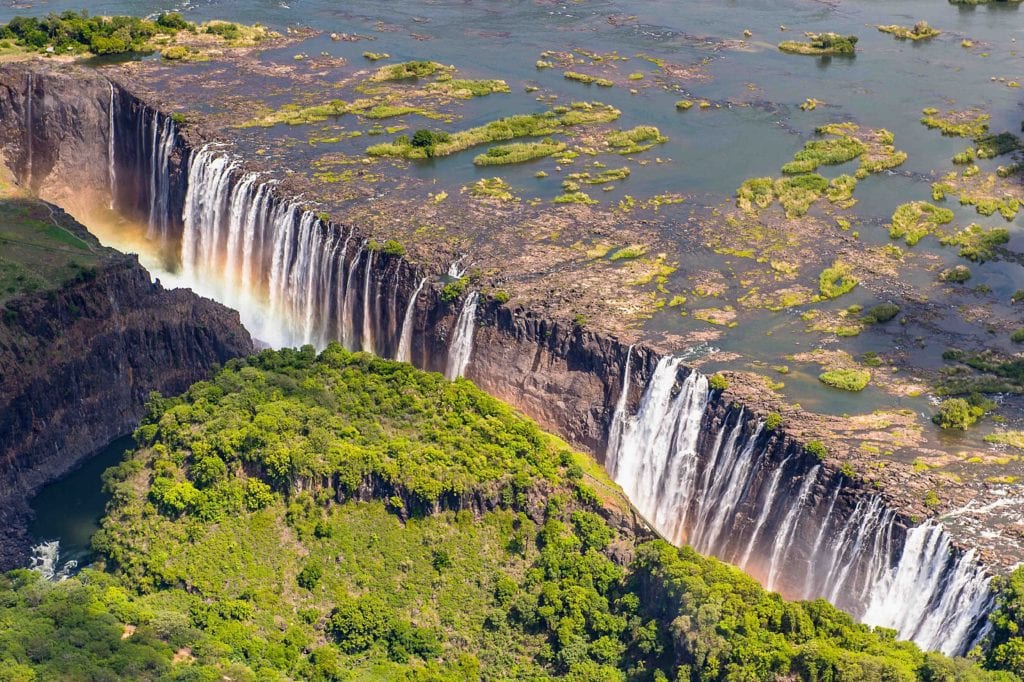
On a helicopter safari, the falls take on a completely different perspective and you are able to trace the riverway from far to the west, over the expansive falls and far beyond as it makes its protracted journey towards the ocean. From land, it is dramatic, even cataclysmic; from the air it takes on a serene beauty, its grandeur still predominant, bug a graceful, balletic dance of water sparkles beneath you under the African sun.
Africa is a sensory, tactile destination. At ground level, there is so much that could never be enjoyed from a couple of thousand feet up. Yet likewise, there are many aspects of this vast continent that are either inappreciable or simply unattainable without the use of a helicopter. Incorporating a single day or extended helicopter safari within your vacation offers you a wealth of sights, destinations and opportunities few others might ever experience.
Talk to our Travel Designers today about taking to the air for an African helicopter safari.

